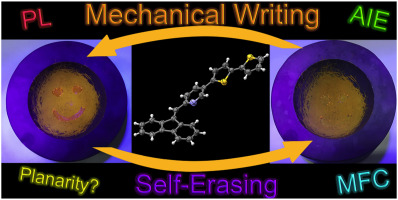The paper of NIOCh's researchers is published in the journal Dyes and Pigments (IF 4.018) :
2-((9H-fluoren-9-ylidene)methyl)pyridine as a new functional block for aggregation induced emissive and stimuli-responsive materials
Anatoly D.Kuimov, Christina S.Becker, Igor P.Koskin, Daniiar E.Zhaguparov, Alina A.Sonina, Inna K.Shundrina, Peter S.Sherinb, Maxim S.KazantsevDyes and Pigments, Volume 181, October 2020, 108595
First online: June 2, 2020
https://doi.org/10.1016/j.dyepig.2020.108595

Abstract
Highly-emissive mechanofluorochromic (MFC) organic solids changing their emission colors upon exposure to mechanical stimuli are highly demanded for various practical applications. In this work we introduced a planarizable by intramolecular N⋯H bond 2-((9H-fluoren-9-ylidene)methyl)pyridine fragment featuring an Aggregation-Induced Emission Enhancement and, particularly, MFC property for its bithiophene derivative. A two compounds, 2-((9H-fluoren-9-ylidene)methyl)-5-(5-phenylthiophen-2-yl)pyridine (FTP) and 2-((9H-fluoren-9-ylidene)methyl)-5-([2,2′-bithiophen]-5-yl)pyridine (FTT) were synthesized and fully characterized. In liquid solution both compounds are low emissive, however in the solid state they exhibit the photoluminescence quantum yield of 33% and 13% for FTP and FTT, respectively. Remarkably, the powder of FTT demonstrates a self-reversible mechanofluorochromism: the emission spectrum red-shifts after the grinding or pressurization and it recovers during one-day of storage without any treatment. The powder X-ray diffraction and differential scanning calorimetry revealed the reversible phase transition under temperature and mechanic stimuli. Analysis of molecular structure shows that in the gas phase FTT has a planar geometry while in the solid state it loses the flatness due to the crystal environment. Our results speak in favor of the increase of FTT planarity under the pressure to be responsible for the observed mechanofluorochromism.
Altmetrics:


